Family : Lymantriidae

Text © Prof. Santi Longo

English translation by Mario Beltramini
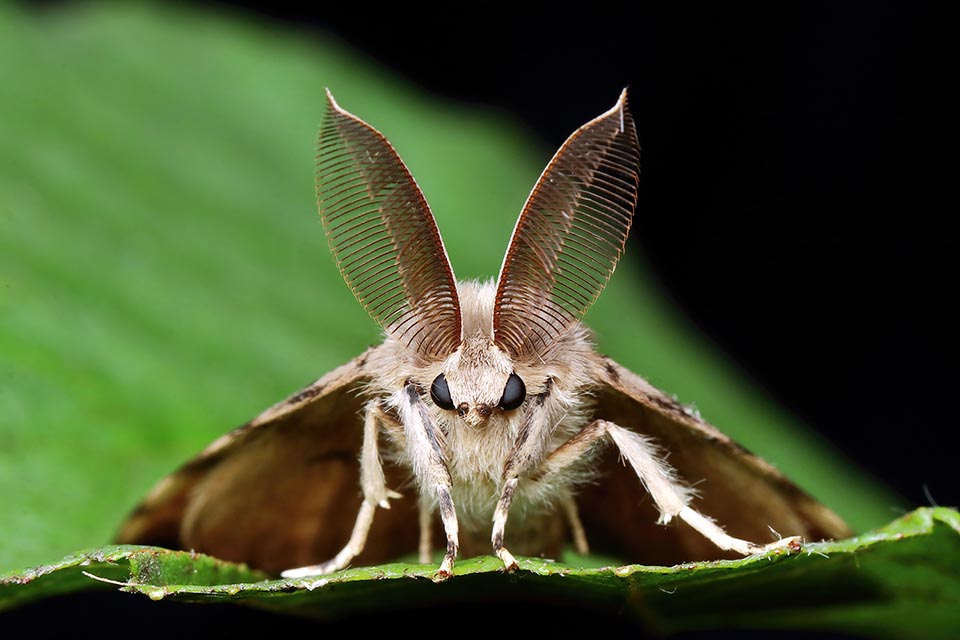
Lymantria dispar has a very vast range including most of the boreal hemisphere. When just flickered, the males look at once for a high site from which, thanks to very sensitive pectinate antennae, they intercept even at great distances the attractive scent trails of the sexual pheromones left by the virgin females © Jason McCombe
Lymantria dispar is the defoliating lepidopteran that, periodically, causes the greatest damage to the forest heritage of vast Euro-Asian territories where it is present since more or less recent times.
The generic term Lymantria, from the Greek lymàinomai, meaning to destroy, recalls the serious damage it caused to the plants, whilst the specific term dispar, different, diverse in Latin, refers to the remarkable difference between adult females and males.
Zoogeography
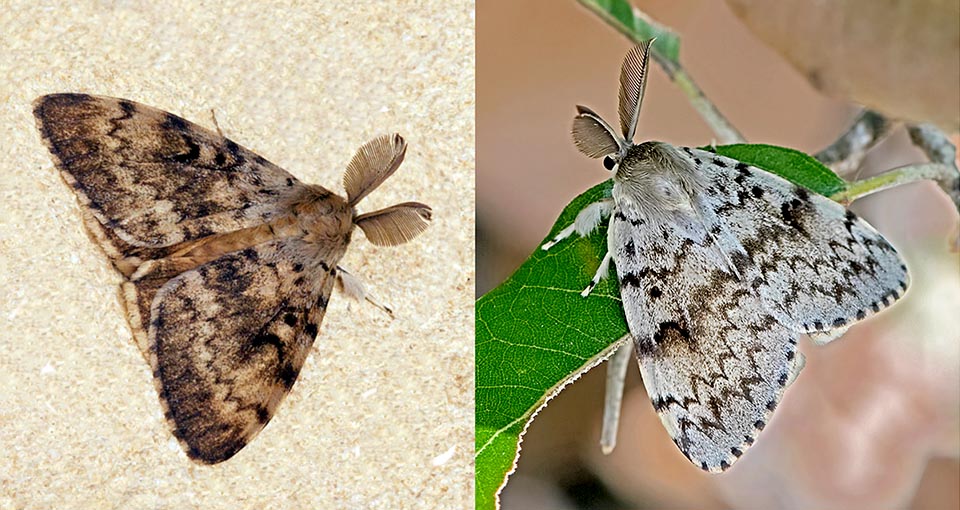
Their colour varies from dark brown to greyish with zig-zagging dark striae on the forewings © Roger Wasley (left) and © Tim Stratford (right)
Now practically cosmopolitan, Lymantria dispar is amply diffused in Europe, in North Africa and in almost all Asia.
In 1868 Leopold Trouvelot introduced in the city of Melford, Massaxcussetts, some specimens to attempt climatization and hybridization with the Silk moth (Bombyx mori) in order to improve the production of the silk and enhance the silk industry in North America.
As it could be expected, this reckless tentative failed but some specimens of the lepidopteran got out from a window of the laboratory, acclimatized and created an outbreak, from where their descendants, in a period of thirty years, diffused in North America and in 1890 the larvae of the following generations did cause serious severe defoliations up to the outskirts of New York.
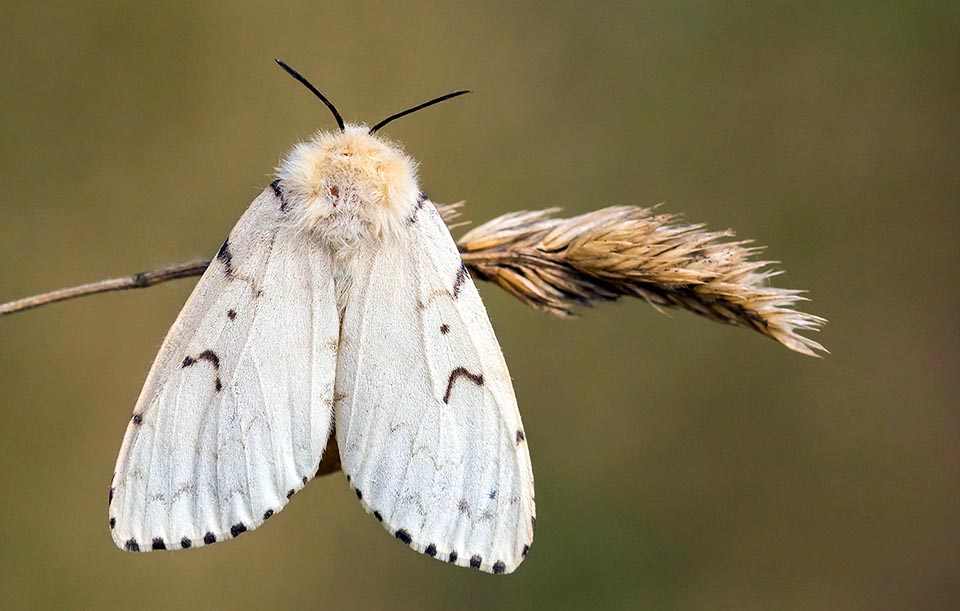
The candid females waiting for them, are vert bad flyers due to their big abdomen full of eggs, but climb supports for entrusting the wind their messages © Tamás Nestor
The following three subspecies have been reported in Eurasia: Lymantria dispar dispar, Lymantria dispar japonica and Lymantria dispar hokkaidolensis.
The genetic analysis has allowed us to ascertain that the populations present in the Far East are different from the Euro-American ones. Some of their strains, with excellent female flyers and even more polyphagous larvae, could arrive in the West creating serious problems to a large number of spontaneous and cultivated plants. In Europe important outbreaks occur frequently in the woods of the Balkans and in the Apennine woods of some Italian regions, as well as in the oakwoods of Sardinia, of Sicily, of the Prealps, of Trentino and of Venezia Giulia.
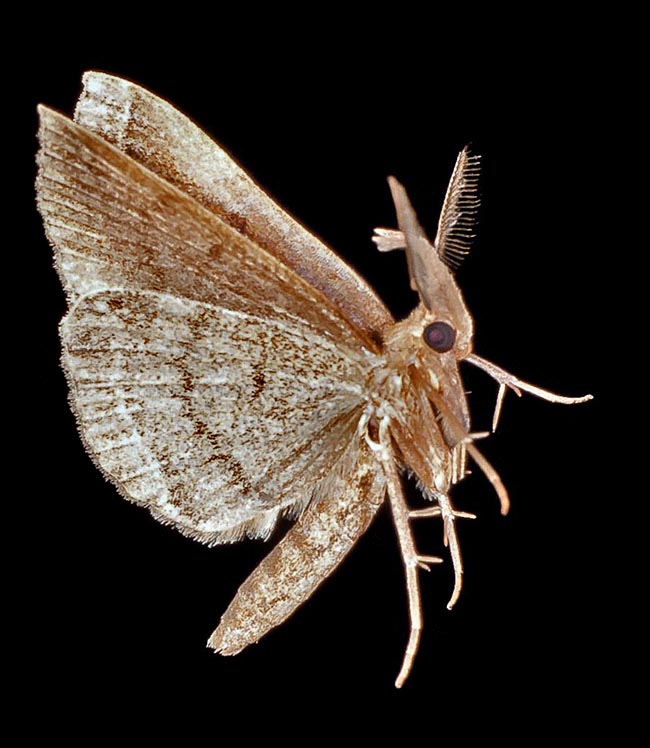
Conversely, the males are very light and with a 35-50 mm wingspan they easily follow, flying, the scent trails © Frans Eggermont
Ecology-Habitat
The larvae are polyphagous and live at the expense of more than forest essences (Betula, Crataegus, Populus, Quercus, Ulmus, Salix, etc.) and bearing fruits of the genera Malus and Prunus.
Occasionally, they have been found also on conifers (Larix, Picea) and in Sicily a larva matures on Eucalyptus camaldulensis.
In the years where the populations increase progressively (phase of progradation), the larvae cause extensive defoliation especially to the Oaks (Cork oak, Holm oak, Downy oak, etc.).
The forest broad-leaved trees, in the areas seriously infested, after the spring defoliation that gives them a winter attitude, by late summer and in autumn, emit a new vegetation giving up the reserves accumulated during the previous years.
Therefore, if the attacks last for several years, the plants perish and are more subject to diseases and attacks of lignicolous insects that may lead them to death.
The plants of Cork oak due to intense defoliation decrease their production of cork by 50%.
The fruit plant suffering the most damage is the Cherry tree (Prunus avium) because of the defoliation and of the premature dropping of the fruits after the cutting of the petiole done by the larvae.
The fruits of pear tree, apple tree, plum tree, apricot tree and peach tree are eroded more or less superficially. These damages happen in plants near woods of broad-leaved trees, during the years of serious infestations.
Morphophysiology
Peculiar feature of the adults is the showy sexual dimorphism. The body of the males is 15-20 mm long and the colour of the wings is variable, from more or less dark brown to greyish.
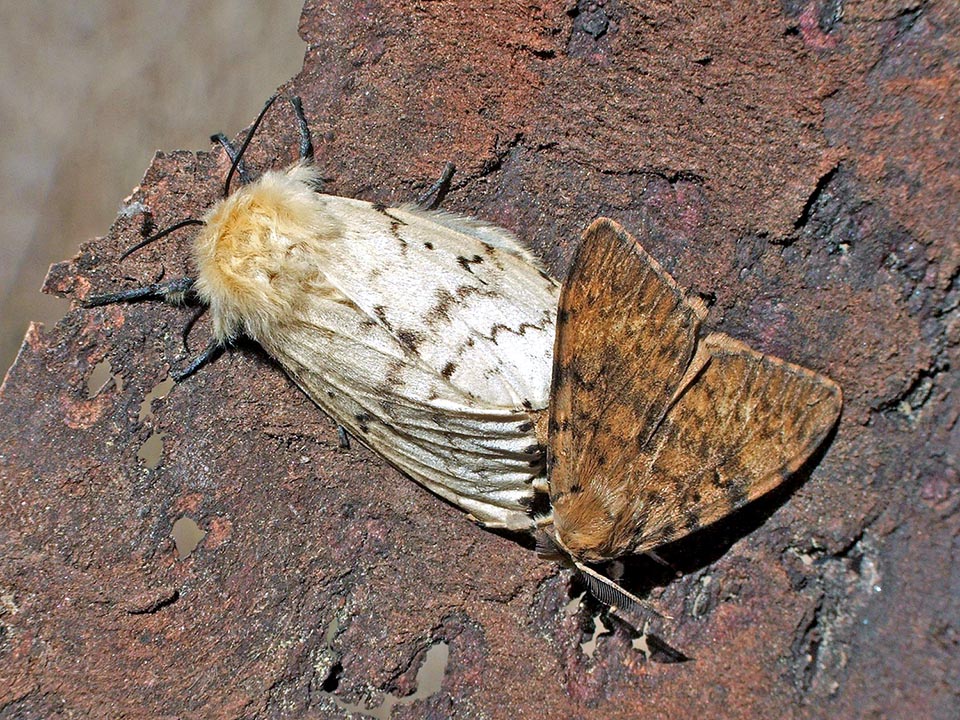
Once reached the female the male emits aphrodisiac smells. If she is available and replies adequately, mating will happen © Rui Andrade
In the head, the antennae have a very developed flagellum and are of bipectinate type with long and developed teeth where are located several sensory organs called sensilla.
In the forewings are present zig-zagging bands of brown colour or or less nuanced. The wingspan varies from 35 to about 50 mm, this allows it to make long flights following the scent trails emitted by the virgin females.
The body of the females is whitish and its dimensions vary from 25 to 30 mm. The antennae, of dark colour, are of bidentate type, with short teeth all alike. The forewings are whitish with four transversal black zig-zagging stripes, often shaded.
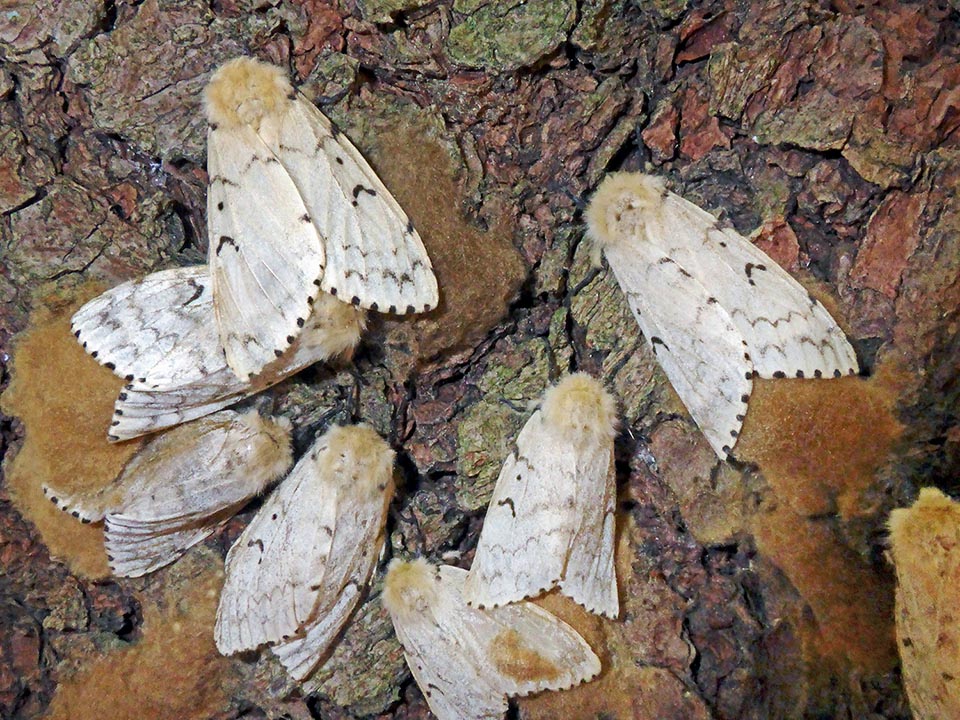
In the years when adults are particularly numerous, several females gather close in the sites more suitable for the oviposition © Kristof Zyskowski & Yulia Bereshpolova
The abdomen is stocky and swollen as it contains the numerous that have formed in the ovaries, therefore they are not able to effect long flights and fly here and there or walk among the vegetation where they attract the males. On the abdomen are present several tawny hairs, useful for protecting the eggs in the egg-layings.
Are reported individuals where half of the body presents males characters and the other half female. This phenomenon known as gynandromorphism occurs alsi in other lepidopterans when an individual belonging to a species whose species are different, presents parts of the body with male characters and other ones with female characters, due to the unbalanced distribution of the chromosomes during a division of the embryonic cells.
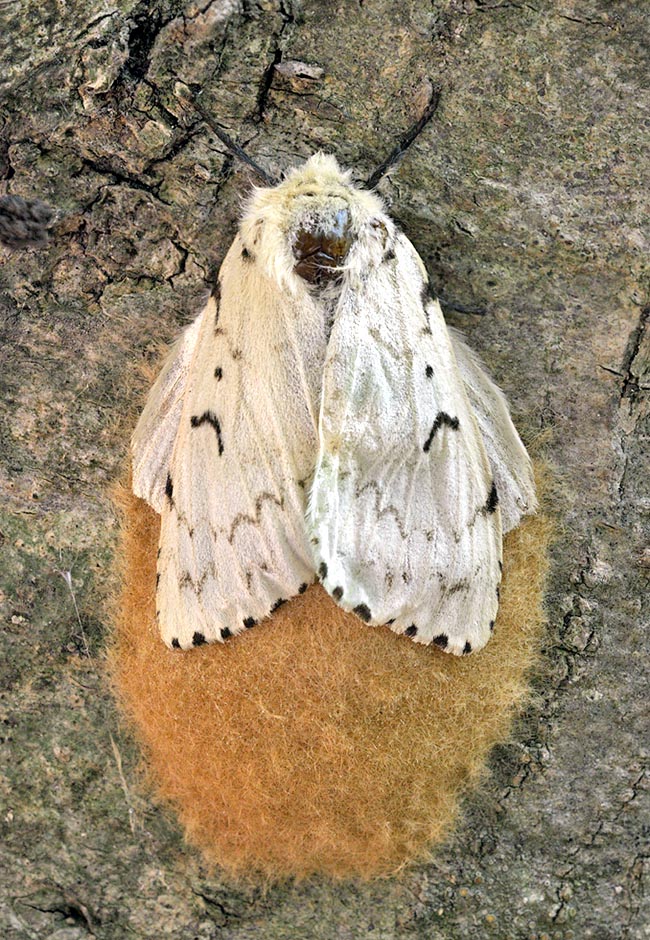
Right after mating, males die, and the females later on, only when they have well covered the laid eggs with layers of reddish hairs detached from the abdomen in order to protect the ovature from heavy rains © Dmitry V. Ivanoff
The eggs, of a diametre of about 1 mm, have a spherical shape flattened on the poles. They are laid on more layers, in egg-layings having an oval shape, elongated and covered by tawny hairs that the female detaches from its own abdomen giving the completed ovatura a felty consistency.
The colour of the body of the various larval phases presents a remarkable variability; some forms are almost black; others are pale grey with showy dorsal tubercles.
The newly born larvae have the body of black colour on which are present several broad aerostatic hairs.
The larvae of the following ages have the head of yellow-brown colour; in the thorax and in the abdomen, gradually appear coloured areas.
The tufts of bristles present in the first segment of the thorax are considerably developed and directed forward.
The mature female larvae have the body about 7 cm long, the male ones are shorter.
In both sexes the fundamental colour is brownish mottled with grey and yellowish with six tubercles per segment equipped with big tufts of bristles. In the first five segments they are blue, whilst in the remaining ones they are red.
The chrysalises have a stocky shape and are of reddish brown colour. The fore part is rounded and wider than the back one ending in an elongated process from where start a few silky threads secreted by the eopupa for anchoring on the support.
If the density of the population is not high the eopupae remain isolated, whilst in the culminating phases of the gradations, they keep close and weave around the body a thin weft of silky threads where remain incorporated larval exuvias and leaves and form, in such way, a sort of shelter on the branches, or stuck to the trunk, from which some may accidentally fall on the underlying leaves or on the soil.
Ethology-Reproductive Biology
The species develops an annual generation and winters as first age larva, inside the egg.
The young larvae shell out in spring and in the first two days the remain close to the ovature, then they are attracted by the light and reach the highest and most exposed parts of the top to which they fix one end of the silky thread, secreted by them, letting themselves dangling in the void and letting themselves to be carried by the wind even quite far away.
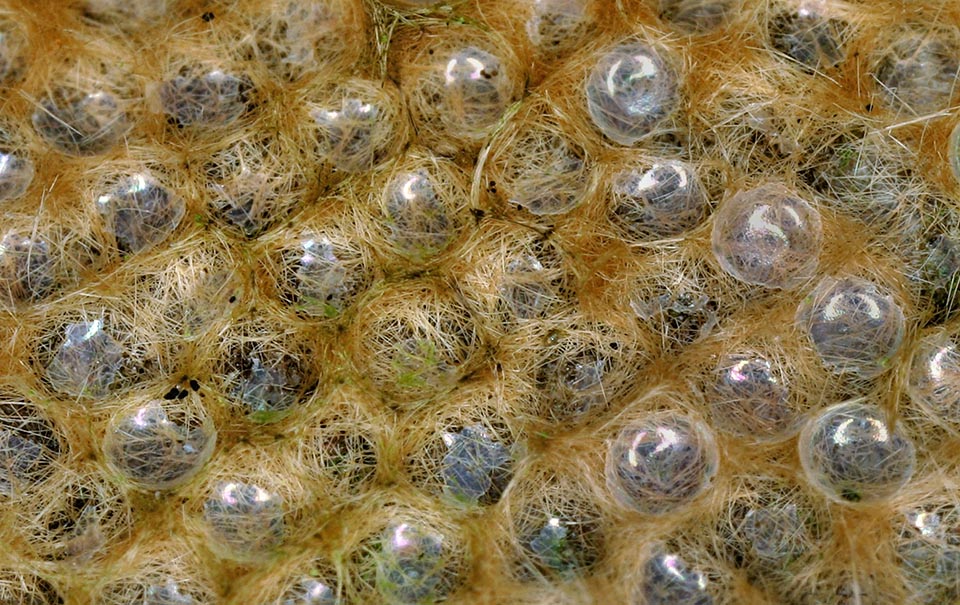
Larvae wintering inside eggs. About 1 mm broad, they are covered by tawny hairs the female takes off from its abdomen and grant the ovatura a felty consistence © Christian Hugues
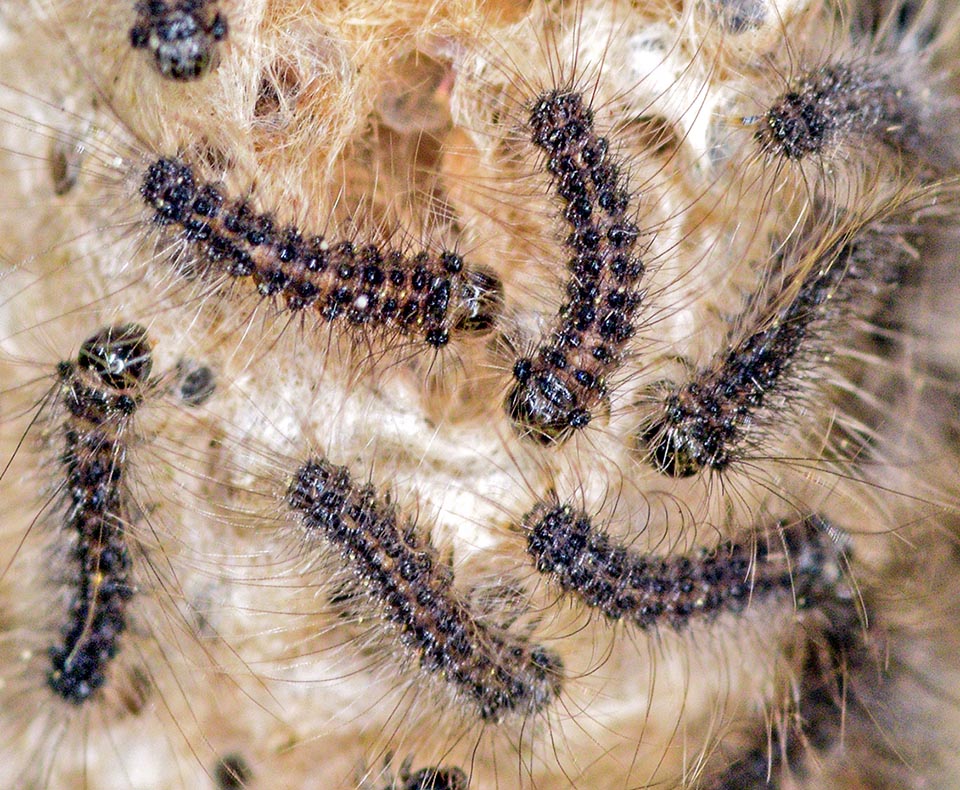
Newborn larvae, usually black, keep close to the ovature for about two days. Attracted by the light, on the third day they move on the high parts of the cyme from where, dangling in the wind attached to a long thread, reach the surrounding plants where they lead a lonely life devouring the leaves of the host plant © Thomas Palmer
The larvae of the following ages are active during the night hours when, with their strong mandibles, gnaw the leaves sparing only the petioles.
The fourth and fifth age are ravenous and after having defoliated the host plant, go in search of food often climbing the walls of the buildings they can enter. The larval development of the females completes in about two months, whilst the males’ ones have a shorter duration.
The eopupae reach the sites where they will complete their metamorphosis in about fifteen days.
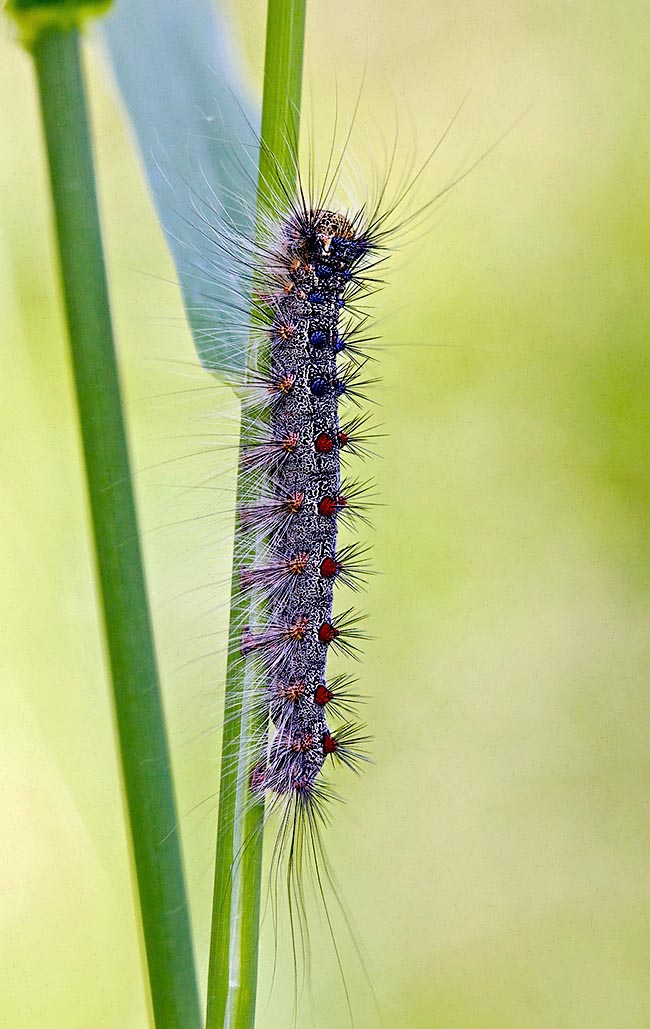
This young caterpillar, eaten all leaves, has gone down to the soil to move to a new tree © Gediminas Gražulevičius
The male chrysalises, whose larval life has been shorter than that of the females, take more time for flickering, therefore the epoch of appearance of the two sexes is almost coincident.
The first adults flicker in late June, their density reaches the peak in July and ends in September.
Two annual generations have been reported in the USA, with the hatch of the eggs also in autumn.
The males are active during the day and often go flying together; they die soon after coupling whilst the females exhaust after having completed the ovature.
The latency periods, during which the specimens present are not numerous and in balance with the environment resources, have a duration varying from four to twenty or more years.
During the latency phase the females after the mating and the fecundation oviposit at various heights of the trunk and of the big branches, whilst during the progradation the ovaturas are formed also on leaves or on various supports (stones, anfractuosities of the walls, etc.) up to two metres from the soil.
In the years when the highest densities of populations are reached, the ovatures can be found on the trunks at heights exceeding the two metres.
In each ovature in the the phases of culmination of the gradations are present 300 to 500 eggs, whilst in the latency and the progradation ones the number of elements varies from 600 to 800 with peaks of about 2.000.
There is a close correlation between the number of eggs and length of the ovature whose longitudinal diametre varies from 3 to 6 cm, and the transversal one from 1,5 to 2,5 cm.
After 3-6 weeks from the spawning, inside the shell, get form the larvae that remain in diapause until April-May of the following year, coinciding with the emission of the sprouts that are rapidly destroyed.
The newborn larvae after two days of common life disperse on the foliage of the plant where they were born or reach more or less close plants.
Until the second age they are active during the day, later on they feed mainly at dusk and at night.
The larval development completes in June-July in a period variable from six to twelve weeks.
The adults flicker after a period of two or three weeks from the chrysalises.
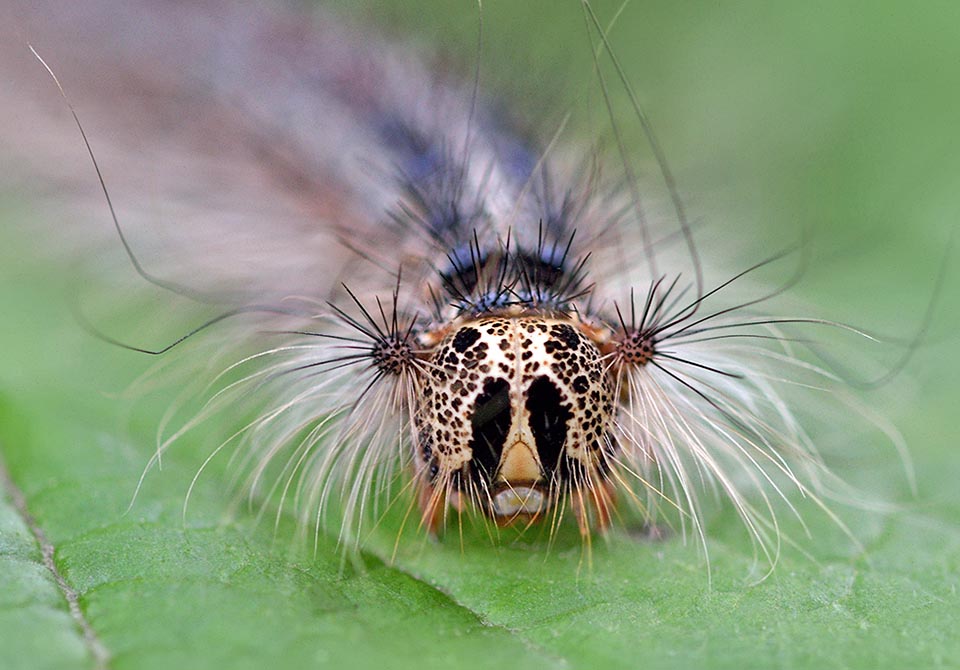
The following ages larvae are equipped with a robust mouthpart. On the first segment of thorax are present two characteristic long tufts of hairs facing forward © Dmitry V. Ivanoff
The explosive phases, called of progradation, may interest very vast areas; in 1982 in the Northeast of the USA have been invaded four million of hectares.
The biotic potential of the species, from which depends the extent of the expected defoliation, is expressed as the number of eggs produced by a single female and is put in relation with the availability of preferred plants. These elements along with the warm and dry weather are favourable to the starting of the pullulations.
In the phases during which the highest densities of populations are reached, defined peaks of the progradation, the number of ovatures laid in the lower parts of the plants increases.
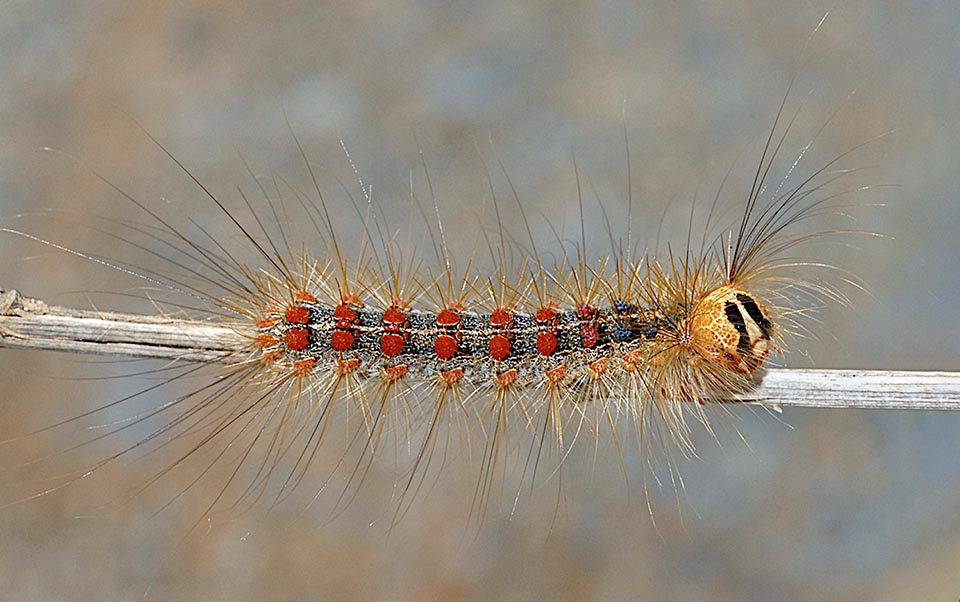
Also for avoiding predators, the mobile and greedy larvae of fourth and fifth age are active only in the night and in the very cloudy days © Robert Combes
From the outbreaks of infestation the larvae migrate to peripheral areas not interested in the deposition where the natural foes are limited in number and where the food is abundant. If these zones are degraded, the species can keep in high densities of population for several years.
Serious infestations and defoliations occur in Sardinia every five or six years, in other regions of South Italy and in Sicily, every about twenty years.
Normally, the pullulations last from two to four years and cease due to various mortality factors such as the competition for the food and the natural foes active mainly during the phases when the density of the population is high.
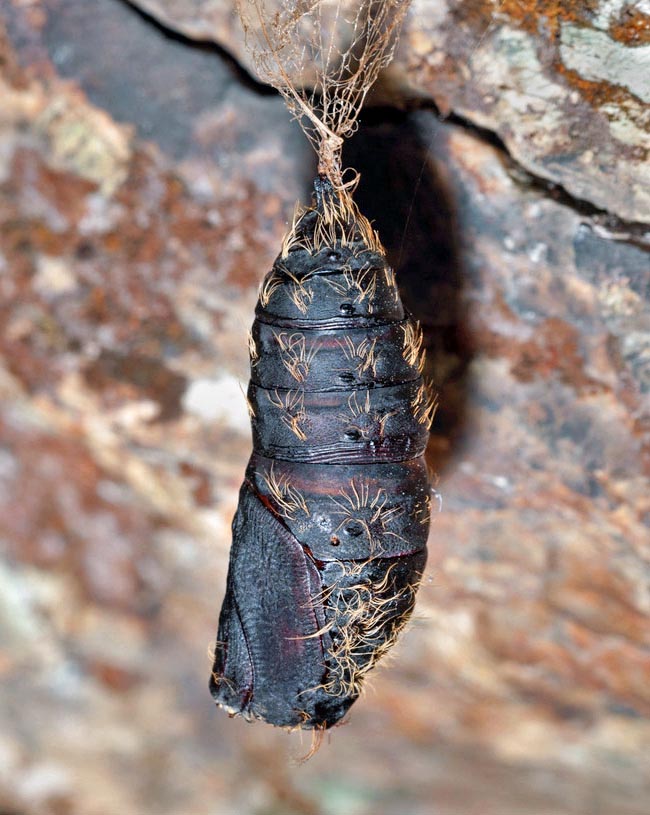
When mature the eopupae look for the most suitable sites for hanging from a stand and effect the metamorphosis © Tonci Maletic
The monitoring of the populations is done in the woods and in the orchards with special traps, available commercially, triggered with the pheromone known as Glycure, after the common name Gypsy Moth, under which the insect is known.
This substance has an attractive power towards the males, bigger than that of the pheromone produced by the females.
However their employment for the purpose of fighting with the mass capture method, that foresees the attraction and capture of more than the 90% of the males present in a certain zone, has not given acceptable results in terms of defence of the plants, as not all males enter the traps where the synthetic pheromone is only one of the components if the mixture of substances emitted by the female.
Moreover, some males mate only after that the females respond adequately to the aphrodisiac substances emitted by them.
In nature, numerous pathogens: Viruses, Bacteria, Fungi and Protozoans infect the lepidopteran causing major epidemics, called epizootics.
Active predators are various Birds, arboreal Rodents, as well as Dermestid Coleoptera and Carabids, the most active of which is the Calosoma sycophantha, of which, in the first half of the 19th century, Boisgiraud freed some specimens in Poitiers for fighting an infestation of Lymantria dispar on the poplars, thus realizing, one of the first interventions of biological combat done in Europe.
The Hymenopterans Ooencyrtus kuwanae and Anastatus bifasciatus parasitize the eggs located in the more superficial layers of the ovatures, however, if these ones are damaged by the predators the above-mentioned parasitoids can reach a high percentage of the eggs of the lower layers.
More numerous and important are the parasitoids of the larvae, particularly the Tachinid Dipterans Exorista larvarum and Blepharipa pratensis as well as the Braconid Hymenopteran Apanteles portheriae whose larvae after having developed inside the body of the larva of Limantria pupate outside in characteristic small cocoons.
An active parasitoid of the chrysalises is the Braconid Hymenopteran Brachymeria intermedia.
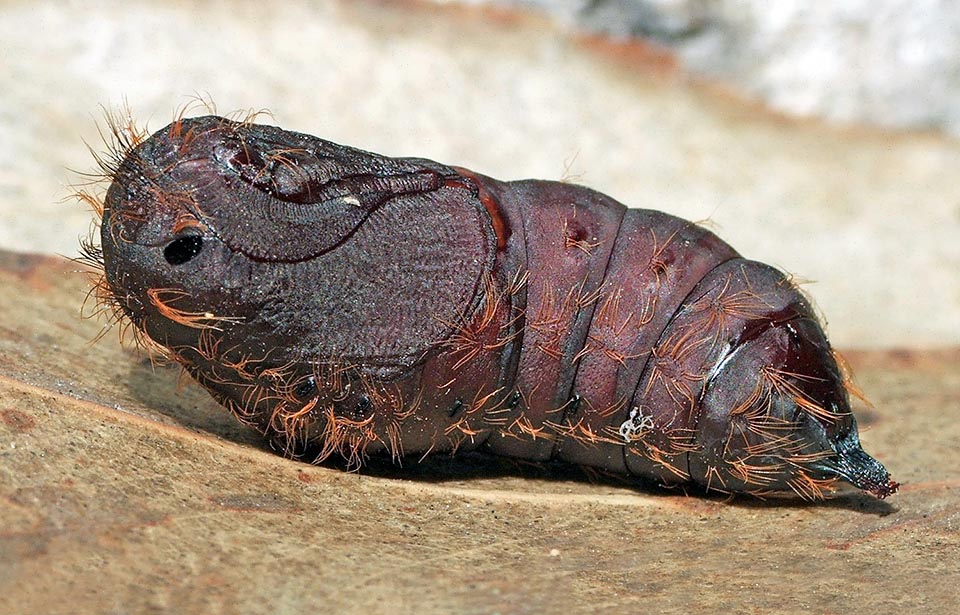
In the chrysalis staying on a leaf we note the head with the proboscis, the shape of wings and of abdominal segments © Rui Andrade
For the biological struggle, in Europe are employed commercial formulations based on the toxin produced by the entomopathogenic bacterium Bacillus thuringiensis that cause high mortality of the young larvae.
In North America has been identified the entomopathogenic fungus Entomophaga maimaiga that has decimated the populations of the Limantriid and it has been produced and commercialized for interventions of biological control in the broad-leaved woods.
Synonyms
Phalena dispar Linnaeus 1758, Ocneria dispar Grum-Grshimailo,1890; Liparis dispar Swinhoe,1923; Lymantria (Porthetria) dispar Schintlmeister, 2004.
→ For general notions about the Lepidoptera please click here.
→ To appreciate the biodiversity within the BUTTERFLIES please click here.
